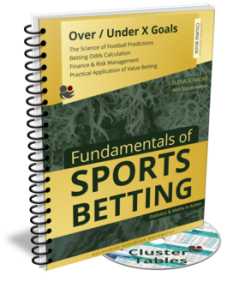
In conjunction with our regular match previews published in the German Betfair blog we are pleased to present our league match with head-to-head history ‘Value’ bet detector spreadsheet.

with H2H History
WITH Asian Handicap
(ex VAT; see below)

WITHOUT Asian Handicap
(ex VAT; see below)

0% VAT to UK customers
0% VAT to Non-EU customers
Read more: EU VAT Legislation
e-shop: Product Overview
View Your Shopping Cart
Our bet selections are always based on true odds calculations identifying mathematical ‘value’ in the markets. Of course, not every bet can win, but ‘value’ betting is the only reliable method of ensuring long-term betting profits.
‘VALUE’ bet detector: The Excel spreadsheet calculates the ‘true’ odds (= expected probabilities based on historical statistics) and then displays each ‘value’ bet recommendation. For every event included the expected values are calculated, compared to market prices, and finally the statistical probability of winning the bet is shown.
Soccerwidow follows the philosophy that only through identifying bets containing mathematical ‘value’ in the prices offered by bookmakers or exchanges is it possible to make consistent profits.
It should be noted that the spreadsheet is not a tool for automated betting. The tables provide vital information to improve the accuracy of your own predictions, and the figures do not substitute for reading salient news and applying good judgement.
The Excel spreadsheet offered for sale comes pre-filled with data from the Premier League game Liverpool v. Manchester City on 26/8/2012. Just delete or over-type this to analyse any match of your choosing.
Read a few sample match previews which apply ‘League Games with H2H History’ calculations:
- 26.8.2012 English Premier League: Liverpool v. Manchester City – Statistical Match Analysis & Football Betting Predictions
- 6.8.2012 Norwegian Tippeligaen: Stabæk v. SK Brann – Statistical Match Analysis & Football Betting Predictions
- 5.8.2012 Belgian Jupiler League: Zulte-Waregem v. Gent – Statistical Match Analysis & Football Betting Predictions
Notes: Adjust the picture quality at the bottom of the screen above by clicking on the ⚙ button (to the left of the YouTube logo), then click on ‘Quality’ and choose a higher resolution as desired. Go to full screen mode by clicking on the box symbol (to the right of the YouTube logo).
Supporting Videos
Data Sourcing: Learn where to find historical match data and download it from www.football-data.co.uk to make your own Excel store of statistics.
Data Input: Historical match results and head-to-head data input to populate the Value Bet Detector ready for input of the best odds you can find.
Frequently asked questions:
Can I use the spreadsheet in other leagues?
Yes, the calculations apply for any league in the world. The only parameters are that the game in question must be between two teams which have played at least their last 25 home or away games in the same league. The calculations are based on the home team’s last 25 home games and the away team’s last 25 away games, in the same league. Also, both teams must have played the corresponding fixture at least 6 times in the last 10 years (in other words, the home team has hosted the away team at least 6 times in all competitions (not friendlies) in the last 10 years).
How long does it take to enter historical data into the spreadsheet?
This is a manual procedure and you will quickly find which sources are best for the full-time and half-time results of both teams in the 25 matches to be analysed, plus the head-to-head encounters. We recommend Football-Data, Betexplorer, Oddsportal and Soccerway, although there are a host of other sites specialising in historical statistics.
At the start, you will find data collection will take about 30 minutes per match including entering the best bookmaker odds you can find (try Betfair and Oddschecker).
Are the formulas for the spreadsheet calculations visible?
Yes, we have hidden none of the formulas.
Exactly which historical records do I have to input?
The full-time and half-time scores for both team’s last 25 matches (home games only for the home team, away games only for the away team), plus the same for the head-to-head encounters over the last 10 years.
What knowledge is required?
You should already have a understanding of odds and how they are calculated. The spreadsheet is just a tool to identify potential bet candidates. You will need to understand what is meant by the term ‘value’ and also have a good idea how to spread risk with a well-structured betting portfolio. The spreadsheet is intermediate level, and you should be become entirely familiar with its mechanics before committing money to any bet recommendations suggested by the spreadsheet.








Dear Soccerwidow,
Would you recommend to choose a back bet when the profitability quotient ( value I / value II) is below 1 ? i.e when the mathematical advantage is greater than the price difference between market odds/real odds. The market i am focused is Asian Handicap and i would really appreciate your thoughts on that particular market.
Once again, thank you for your amazing product !!
Dear Socrates, it really depends on your risk aversion… Value I is ‘profitability’ and Value II is ‘yield’. A high yield stands for high risk. That means that the lower the profitability quotient the higher the risk.
You will need to do a number of paper exercises and see what works for you. Please also pay attention to the distribution of winning and losing bets as longer losing streaks are painful on the nerves.
Hi Right winger? The odds in column N for HT/FT are not average odds. How do you arrive to get the odds?
Hey Elena,
what if I am specialised on Over/Under using the cluster Tables, is the value calculator something I can use additional or would you say using the cluster tables after working through the course is enough for Over/Under?
Cheers Tim
P.S. Pls check your admin@ email, I sended you (in german) an mail few weeks ago, dont know if you received it.
Hi, right now and in the future matches will be played without fans. What do you think does that do to systems that rely on a separation between home and away matches such as your Value Calculator. Are they pretty much worthless since the home advantage is drastically reduced? Any ideas on that?